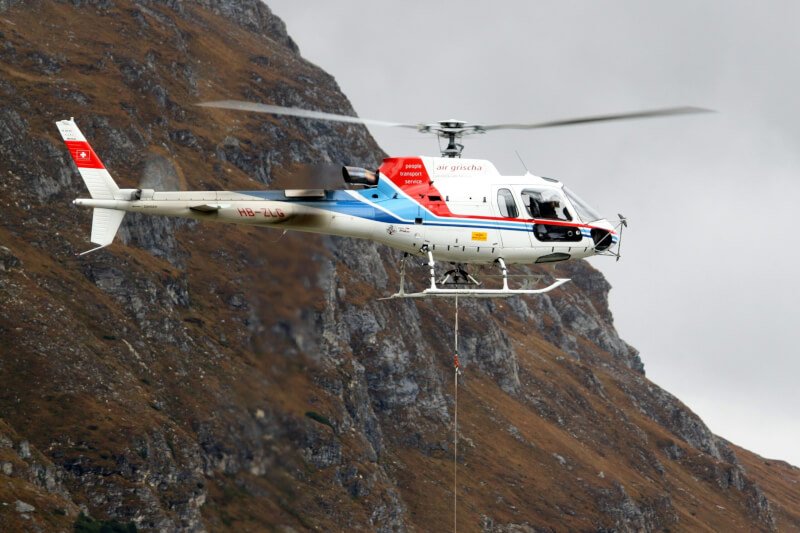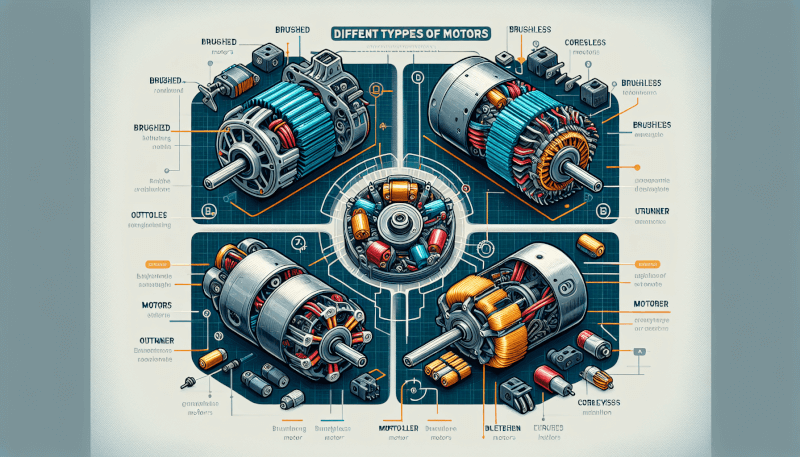In this article, you will explore the fascinating world of RC helicopter motors. Whether you are a seasoned enthusiast or a beginner looking to embark on this thrilling hobby, understanding the different types of motors available is essential. From brushed motors to brushless motors, each type has its advantages and characteristics that can greatly impact the performance and flying experience of your RC helicopter. So, join us as we break down the intricacies of these motors, guiding you towards making the best choice for your next aerial adventure.

1. Brushed Motors
Components
Brushed motors consist of several key components, including a rotor, a stator, brushes, and a commutator. The rotor is a rotating part that contains permanent magnets or electromagnets, while the stator is a stationary part that houses coils of wire. The brushes are responsible for transferring electrical current to the rotor, and the commutator acts as a mechanical switch to ensure that the current flows in the right direction.
Working Principle
In brushed motors, the flow of electricity through the coils of wire in the stator creates a magnetic field. When the current is supplied to the motor, the brushes make contact with the commutator, causing the rotor to spin. As the rotor rotates, the commutator switches the direction of the current, ensuring continuous rotation.
Advantages
Brushed motors have a simple design and are relatively inexpensive compared to other motor types. They also offer a high starting torque, making them suitable for applications that require a quick response.
Disadvantages
One of the main disadvantages of brushed motors is their limited efficiency. The brushes and commutator produce friction and wearing, leading to energy loss and reduced overall performance. Brushed motors also tend to generate more heat and produce more noise compared to other motor types.
2. Brushless Motors
Components
Brushless motors consist of a rotor, stator, and electronic speed controller (ESC). The rotor contains permanent magnets, while the stator houses coils of wire. The ESC is responsible for controlling the speed and direction of the motor.
Working Principle
Unlike brushed motors, brushless motors do not rely on brushes and commutators. Instead, they use an electronic commutation system. The ESC sends electrical pulses to the motor’s stator coils, creating a rotating magnetic field that interacts with the permanent magnets on the rotor, causing it to spin.
Advantages
Brushless motors have several advantages over brushed motors. They are more efficient, produce less heat, and have a longer lifespan. Additionally, brushless motors offer higher power-to-weight ratios, providing greater thrust and improved performance.
Disadvantages
One of the main disadvantages of brushless motors is their higher cost compared to brushed motors. They also require more complex control systems, such as the ESC, which adds to the overall cost. Brushless motors may also require specialized programming or setup to ensure optimal performance.
3. Coreless Motors
Components
Coreless motors are similar in design to brushed motors but with a key difference. Instead of a solid iron core in the rotor, coreless motors use a winded or coiled armature.
Working Principle
Coreless motors operate on the same principle as brushed motors. When current is supplied to the coils in the stator, a magnetic field is created, causing the rotor to rotate. The absence of a solid iron core in the rotor allows for a higher rotational speed.
Advantages
Coreless motors offer several advantages, such as reduced weight, higher efficiency, and lower inertia. They are commonly used in applications where low weight and responsiveness are critical, such as in micro-size RC helicopters or drones.
Disadvantages
One of the main disadvantages of coreless motors is their lower torque compared to brushed or brushless motors. They also may require more frequent maintenance due to the wear and tear of the coiled armature.
4. Outrunner Motors
Components
Outrunner motors consist of an outer rotating case and an inner rotor. The outer case houses the stator, while the rotor, which contains the permanent magnets, rotates around it.
Working Principle
When current is supplied to the stator coils, a magnetic field is generated. This magnetic field interacts with the permanent magnets on the rotor, causing it to spin. The outer case remains stationary during operation.
Advantages
Outrunner motors offer several advantages, including high torque, smooth operation, and the ability to generate greater thrust. They are commonly used in applications that require high power output, such as larger RC helicopters or fixed-wing aircraft.
Disadvantages
One of the main disadvantages of outrunner motors is their larger size and weight compared to inrunner motors. They may not be suitable for applications where weight and size are critical factors. Outrunner motors also tend to have lower maximum rotational speeds.

5. Inrunner Motors
Components
Inrunner motors consist of a stationary stator and a rotor that is designed to rotate inside the stator. The rotor is typically equipped with permanent magnets.
Working Principle
When current is supplied to the stator coils, a magnetic field is created. The permanent magnets on the rotor interact with this magnetic field, causing the rotor to spin within the stator.
Advantages
Inrunner motors offer several advantages, such as compact size, high rotational speed capability, and efficient power delivery. They are commonly used in applications that require smaller, lightweight motors, such as mini RC helicopters or smaller drones.
Disadvantages
One of the main disadvantages of inrunner motors is their lower torque compared to outrunner motors. They may not be suitable for applications that require high torque output. Inrunner motors also tend to generate more heat due to their smaller size.
6. Direct Drive Motors
Components
Direct drive motors typically consist of a rotor and stator, similar to other motor types. However, they may also include additional components such as a gearbox or transmission system.
Working Principle
The exact working principle of direct drive motors can vary depending on the specific design and configuration. In basic terms, direct drive motors convert electrical energy into rotational motion without the need for external gears or belts.
Advantages
Direct drive motors offer several advantages, including high efficiency, low maintenance, and improved responsiveness. They eliminate the need for additional gearbox components, resulting in reduced weight and complexity.
Disadvantages
One of the main disadvantages of direct drive motors is their limited torque output compared to geared motors. They may not be suitable for applications that require high torque or heavy loads. Direct drive motors may also be more expensive compared to other motor types.

7. Geared Motors
Components
Geared motors consist of a motor, a gearbox, and sometimes additional components such as a pinion gear or spur gear. The motor provides the rotational motion, while the gearbox converts the speed and torque to a desired output.
Working Principle
In geared motors, the motor’s rotational motion is transmitted to the gearbox, which then adjusts the speed and torque according to the gear ratio. The gearbox typically contains a combination of gears, such as spur gears or planetary gears, to achieve the desired output.
Advantages
Geared motors offer several advantages, including increased torque output, precise speed control, and the ability to handle heavier loads. They are commonly used in applications that require high torque or for lifting heavy objects.
Disadvantages
One of the main disadvantages of geared motors is their increased complexity and weight compared to direct drive motors. The gears require regular maintenance and may be susceptible to wear and tear. Geared motors may also produce more noise compared to other motor types.
8. Variable Pitch Motors
Components
Variable pitch motors consist of a motor, a rotor with adjustable pitch blades, and sometimes additional components such as a swashplate mechanism. The motor provides the rotational motion, while the variable pitch blades allow for changes in the thrust and lift.
Working Principle
In variable pitch motors, the motor’s rotational motion powers the adjustable pitch blades. By changing the angle or pitch of the blades, the motor can generate varying levels of thrust and lift. The pitch is typically controlled by a swashplate mechanism.
Advantages
Variable pitch motors offer several advantages, including enhanced maneuverability, improved stability, and the ability to perform advanced flying maneuvers. They are commonly used in collective pitch helicopters, where precise control of thrust and lift is crucial.
Disadvantages
One of the main disadvantages of variable pitch motors is their increased complexity compared to fixed pitch motors. The swashplate mechanism and variable pitch blades require additional maintenance and setup. Variable pitch motors may also be more expensive compared to fixed pitch motors.

9. Multirotor Specific Motors
Components
Multirotor specific motors, also known as drone motors, consist of a motor, a rotor, and sometimes additional components such as an ESC. The motor provides the rotational motion, while the rotor generates lift to keep the drone airborne.
Working Principle
The working principle of multirotor specific motors is similar to other brushless motors. They rely on electronic commutation to control the speed and direction. The motor’s rotational motion, coupled with the aerodynamic design of the rotor, allows for stable flight and control.
Advantages
Multirotor specific motors offer several advantages, including high efficiency, improved thrust-to-weight ratio, and the ability to perform agile maneuvers. They are designed specifically for multirotor aircraft, such as quadcopters or hexacopters.
Disadvantages
One of the main disadvantages of multirotor specific motors is their limited applicability to multirotor aircraft only. They may not be suitable for other types of RC helicopters or aircraft. Multirotor specific motors may also require specialized programming or setup for optimal performance.
10. Motors for Collective Pitch Helicopters
Components
Motors for collective pitch helicopters are typically brushless motors that are specifically designed for these types of helicopters. They consist of a motor, a rotor, and sometimes additional components such as an ESC. The motor provides the rotational motion, while the rotor generates lift and controls the pitch.
Working Principle
The working principle of motors for collective pitch helicopters is similar to other brushless motors. They rely on electronic commutation to control the speed and direction. The motor’s rotational motion, coupled with the aerodynamic design of the rotor, allows for precise control of thrust, lift, and pitch adjustments.
Advantages
Motors for collective pitch helicopters offer several advantages, including enhanced control, improved stability, and the ability to perform advanced flying maneuvers. They are designed specifically for collective pitch helicopters, where precise control of thrust and lift is crucial.
Disadvantages
One of the main disadvantages of motors for collective pitch helicopters is their limited applicability to collective pitch helicopters only. They may not be suitable for other types of RC helicopters or aircraft. Motors for collective pitch helicopters may also require specialized programming or setup for optimal performance.
In conclusion, understanding the different types of RC helicopter motors is crucial for selecting the right motor for your specific needs. From brushed motors to brushless motors, each type offers its own set of advantages and disadvantages. Consider factors such as cost, efficiency, torque, and responsiveness when choosing the motor that will best suit your RC helicopter or aircraft.



